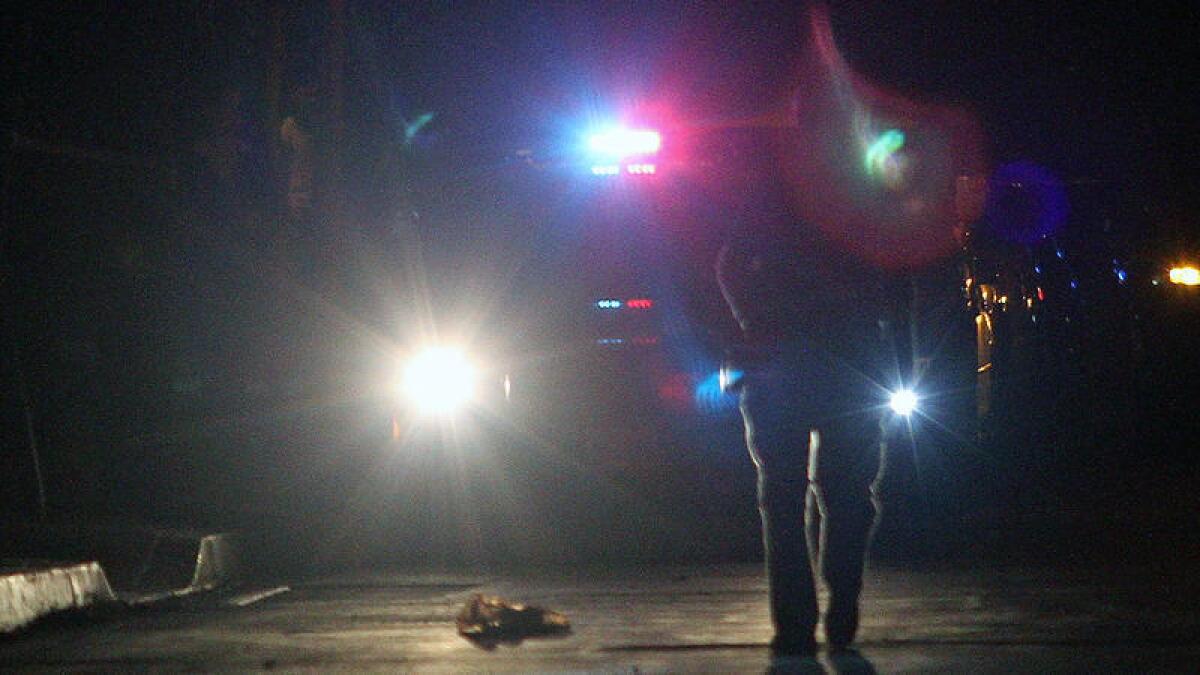Burbank sees a rise in property and violent crimes

A Burbank police officer walks by the shirt of a victim at a shooting scene on Naomi Street and Thornton Avenue, near Robert E. Lundigan Park, in Burbank on Thursday, Feb. 4, 2016.
Burbank saw a 12% increase in the number of reported property and violent crimes in 2016, according to the Burbank Police Department.
In the department’s year-end crime statistics, 3,160 instances of crime were reported in 2016 as opposed to 2,815 in 2015.
Property crime — which includes burglary, theft and auto theft — jumped from 2,656 cases to 2,948.
All areas of property crime saw a spike in reported incidents.
Join the conversation on Facebook >>
Burglaries rose from 295 to 394 cases, thefts from 2,138 to 2,275 and auto thefts from 223 to 279.
Violent crime — which includes murder, robbery, rape and assault — jumped more than 32% from 159 incidents in 2015 to 211 last year.
While the number of robberies stayed steady at 50, the number of rapes saw a sharp hike — a 189% increase, from nine cases to 26.
The number of aggravated assaults rose more than 38%, from 98 cases to 136.
Police officials attribute the rise in crime to a set of laws that were enacted in the past several years — Propositions 47 and 57 as well as Assembly Bill 109. Sgt. Derek Green, a spokesman for the department, said the laws have not only sparked an increase in crime in Burbank but statewide as well.
The laws are a “recipe for disaster,” Green said.
“We have not only seen an increase in crime, but have found that these crimes are being committed by the very people who have received little to no repercussions for committing previous crimes, thanks to AB 109 and Proposition 47,” he said. “Accountability is less, and, therefore, people are not as afraid to commit crime.”
Proposition 47, passed by voters in 2014, reduced certain drug and property crimes from felonies to misdemeanors.
Proposition 57, approved last year, made changes to sentencing laws in the state and allowed prisoners convicted of nonviolent felonies to become eligible for early parole.
Assembly Bill 109, the state’s prison realignment law, shifted the responsibility of overseeing certain offenders from the state to counties.
Law-enforcement agencies across the state, not just in Burbank, have been critical of the laws since their inception — arguing they have made policing harder and put more criminals back onto the streets.
“Police departments in California are faced with the challenges of solving crimes and making arrests, only to be bound by the initiatives which usually warrant a suspect being released from custody within a few hours of their arrest by way of citation,” Green said.
However, some organizations have said it’s still too early to come to any inclusions about the laws.
The Center of Juvenile and Criminal Justice released a report earlier this month stating that California’s urban crime rate has remained relatively the same during the last seven years despite the passage of the three laws.
Drawing on statistics from the FBI, the center reported that property crime declined by 1%, while violent crime increased by 3% when comparing the first six months of 2016 to the first six months of 2010.
However, the report did point out that rates at the local level have varied widely despite being low across the state. Out of 69 of California’s largest cities, 28 saw a hike in total crime from 2015 to 2016, while 41 saw a decline.
--
Andy Nguyen, andy.nguyen@latimes.com
Twitter: @Andy_Truc
